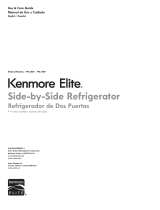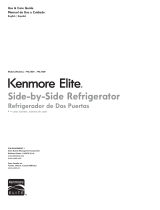LG Electronics LSXS26366S User guide
- Category
- Fridges
- Type
- User guide
LG Electronics LSXS26366S is a sophisticated kitchen appliance designed to meet your refrigeration and freezing needs. It features a spacious interior with adjustable shelves and drawers to accommodate items of various sizes. The refrigerator compartment utilizes Linear Cooling technology to maintain a consistent temperature, minimizing temperature fluctuations and preserving the freshness of your food. The freezer compartment features Smart Cooling Plus System that quickly freezes and stores your frozen goods.
LG Electronics LSXS26366S is a sophisticated kitchen appliance designed to meet your refrigeration and freezing needs. It features a spacious interior with adjustable shelves and drawers to accommodate items of various sizes. The refrigerator compartment utilizes Linear Cooling technology to maintain a consistent temperature, minimizing temperature fluctuations and preserving the freshness of your food. The freezer compartment features Smart Cooling Plus System that quickly freezes and stores your frozen goods.











-
 1
1
-
 2
2
-
 3
3
-
 4
4
-
 5
5
-
 6
6
-
 7
7
-
 8
8
-
 9
9
-
 10
10
-
 11
11
LG Electronics LSXS26366S User guide
- Category
- Fridges
- Type
- User guide
LG Electronics LSXS26366S is a sophisticated kitchen appliance designed to meet your refrigeration and freezing needs. It features a spacious interior with adjustable shelves and drawers to accommodate items of various sizes. The refrigerator compartment utilizes Linear Cooling technology to maintain a consistent temperature, minimizing temperature fluctuations and preserving the freshness of your food. The freezer compartment features Smart Cooling Plus System that quickly freezes and stores your frozen goods.
Ask a question and I''ll find the answer in the document
Finding information in a document is now easier with AI
Related papers
-
LG Electronics LFC22770SB Troubleshooting guide
-
LG Electronics DLEX5000W User guide
-
LG Electronics DLEX9000V User guide
-
LG Electronics LSXC22486S User guide
-
LG Electronics LRDCS2603D User guide
-
LG Electronics LRFCS2503S User guide
-
LG Electronics LTCS24223D User guide
-
LG Electronics LFCS22520S User guide
-
LG Electronics LTCS24223S User guide
-
LG Electronics LTCS24223W Troubleshooting guide
Other documents
-
FAQs What are the best temperature settings for my refrigerator and freezer User manual
-
LG LTCS20220S User guide
-
LG LSXS26366D/03 Owner's manual
-
LG LDCS22220S User guide
-
Kenmore 51733 Owner's manual
-
 Kenmore Elite 79551862611 Owner's manual
Kenmore Elite 79551862611 Owner's manual
-
 Kenmore Elite 51863 Owner's manual
Kenmore Elite 51863 Owner's manual
-
LG LSXC22486S/00 User manual
-
LG LSXS26366D User manual
-
LG LSXS26336S/00 Owner's manual












